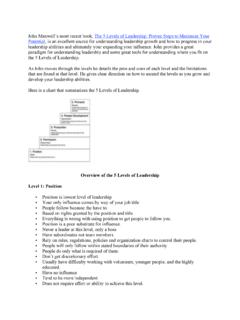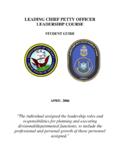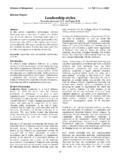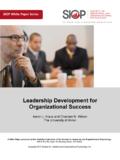Transcription of Leadership Competencies: Are we all saying the …
1 Leadership competencies : are we all saying the same thing? Jeffrey D. Horey Caliber Associates 49 Yawl Dr. Cocoa Beach, FL 32931. Jon J. Fallesen, Army Research Institute Ft. Leavenworth, KS. In the course of developing an Army Leadership competency framework focused on the Future Force (up to year 2025), the authors examined several existing military and civilian Leadership competency frameworks. We attempt to link the core constructs across the frameworks and identify similarities and differences in terms of their content and structures. We conclude that Leadership competency modeling is an inexact science and that many frameworks present competencies that mix functions and characteristics, have structural inconsistencies, and may be confusing to potential end users. Recommendations are provided to improve the methods and outcomes of Leadership modeling for the future. Table 1 represents many of the traits and characteristics commonly found in Leadership competency frameworks.
2 At first glance it may appear to be a comprehensive framework for leaders. It includes values (principled, integrity), cognitive skills (inquiring, thinking), interpersonal skills (caring, enthusiastic, communicating), diversity components (tolerance, respect, empathetic), and change orientation (open-minded, risk taking). Table 1. Sample Leadership competencies Inquiring Thinking Communicating Risk Taking Principled Caring Open-Minded Well Balanced Reflective Committed Confident Cooperative Creative Curious Empathetic Enthusiastic Independent Integrity Respect Tolerance Surprisingly, this is not an established Leadership framework but rather a list taken from a 4th grade student profile guide. While a simplistic example, it illustrates both the universality of the competency concept and the potential confusion when associating a simple list of traits and processes with Leadership . WHAT IS Leadership ? This, of course, is the $64,000 question (maybe it's now the Who Wants to be a Millionaire question?)
3 As the Armed Forces face a rapidly evolving and complex future threat environment, it is crucial that Leadership in these organizations be well defined, described and inculcated. Part of this challenge includes establishing a common language for discussing Leadership concepts and ensuring consistent assessment, development, reinforcement, and feedback processes are in place for maintaining Leadership across our forces. So, again, what is Leadership ? Apparently, decades of research, dozens of theories, and countless dollars haven't completely answered this question. If it had, then we wouldn't have vastly different visions of Leadership and Leadership competency across similar organizations. Or would we? An acceptable definition of Leadership might be influencing, motivating, and inspiring others through direct and indirect means to accomplish organizational objectives.' Defining Leadership is an important first step toward establishing how it should be conducted within an organization.
4 However, a simple definition is insufficient for describing the nature, boundaries, contexts, and desirable manifestations of Leadership . Enter the evolution of competencies . WHAT IS THE PURPOSE OF competencies ? Behavioral scientists and organizational development professionals seek to improve individual and group work processes through the application of systematic procedures and research-based principles. Job analysis techniques, and to a lesser extent competency modeling, have long been used to establish the requirements of jobs and positions throughout organizations and provided input to selection, training, and management practices. Knowledges, skills, abilities, other characteristics (KSAOs), tasks and functions, and more recently competencies have become the building blocks of Leadership selection and development processes. competencies have become a more prevalent method of identifying the requirements of supervisory, managerial, and Leadership positions, rather than job or task analysis techniques, because they provide a more general description of responsibilities associated across these positions (Briscoe and Hall, 1999).
5 Employees want information about what they are required to do (or confirmation of what they think they are supposed to do) in their jobs or positions. The operative word here is do'. They typically do not want to know what they are supposed to be'. This simple representation of Leadership requirements helps us establish a context for evaluating Leadership competencies and frameworks/models. Those that are stated only as traits, characteristics, or in attribute terms are, in our estimation, less valuable than those that are stated in task, function, and behavioral terms. However, models that address both aspects of Leadership may prove to be more valuable to more individuals. The purpose in establishing competencies for leaders should be to better define what functions leaders must perform to make themselves and others in their organizations effective. Many competency definitions include reference to clusters of knowledges, skills, abilities, and traits that lead to successful performance (Newsome, Catano, Day, 2003).
6 Yet competency labels are typically expressed in either process or functional terms. This can lead to confusion as to what competencies actually represent for Leadership and organizations. Competency frameworks or models should serve as the roadmap to individual and organizational leader success. The value of competencies is in providing specific or at least sample actions and behaviors that demonstrate what leaders do that makes them successful. Therefore the end goal of all frameworks or models should be to provide measurable actions and behaviors associated with Leadership functions. Functions are a step removed from this goal, while KSAOs, traits, and attributes are yet another step removed. Leadership competency modeling has been in vogue for several decades but the methods for developing these models and the content are as varied as the organizations for which they have been developed. Briscoe and Hall (1999) identify four principal methods for developing competencies and Newsome, Catano, and Day (2003) present summaries of competency definitions and the factors affecting their outcomes.
7 COMPONENTS OF competencies . The components of competency frameworks are seemingly as varied as the competencies themselves. competencies are generally no more than labels that require additional detail to communicate how they relate to Leadership and behavior. This detail may come in the form of definitions, elements or subcomponents of the competencies , and behaviors, actions or other indicators of manifesting the competency or elements. More detailed frameworks may include hierarchies of competencies or elements based on levels of Leadership or other distinctions. In some cases, it's unclear what the higher order labels ( , Leading Change, Performance) should be called. We must also preface our discussion by admitting it is not completely fair to judge any frameworks by a high level, surface comparison of the labels and definitions/descriptions of the competencies and components. We did use as much of the definitions and description of the framework components as possible in making our comparisons.
8 A more accurate analysis of these frameworks would involve an elemental analysis of each framework construct that is beyond the scope of this paper. However, it is this high level aspect of the framework that, in some sense, sets the stage for the acceptance and comprehension of the framework by the intended audience. NOW, ON TO THE Leadership FRAMEWORKS. We wish to thank the Center for Strategic Leadership Studies at the Air War College for inspiring this paper with their extensive presentation of military and civilian Leadership issues. If you are not familiar with their website ( ), we encourage you to explore it. We chose to review Leadership frameworks from the four major services, the Coast Guard, and the Executive Core Qualifications that apply to senior civilian leaders within the federal government. Table 2 presents overview information for the frameworks that includes the service entity, sources for the frameworks, and components that we investigated.
9 Initially, we sought to determine the similarity of constructs across the frameworks. In the course of this comparison we also recognized variation in the types of constructs represented within a particular framework, overlap among the components, and different levels of detail across the frameworks. We discuss each of these as well. Table 2. Overview of Competency Frameworks Service Coast Guard Army Marine Air Force Executive Navy*. Corps Core Qualifications Source COMDTINST Field Manual USMC AF Senior Office of ;. 22-100 Proving Level Personnel Naval Grounds Management Management Leadership Office Training Unit Components 3 Categories, Be, Know, Do: 11 3 Main areas, 5 Areas, 27 4 Guiding Framework 21 competencies 7 Values, 3 Principles, 24 competencies Principles, 5. Attributes, 4 14 Traits competencies Areas, 25. Skills, 12 at 3 Levels of competencies Different Leadership Actions at 3 (Tactical, Levels of Operational, Leadership Strategic).
10 (Direct, Organizational, Strategic), Performance Indicators * the Navy Leadership competency framework is currently in revision and a copy of the most recent version was not available at the time of publication. Four guiding principles are highlighted, two of which are also considered main areas. Definitions of Leadership or Leadership competency for the frameworks we investigated are as follows: Coast Guard Leadership competencies are measurable patterns of behavior essential to leading. The Coast Guard has identified 21 competencies consistent with our missions, work force, and core values of Honor, Respect, and Devotion to Duty. (COMDTINST ). Army influencing people by providing purpose, direction, and motivation while operating to accomplish the mission and improving the organization. Leaders of character and competence act to achieve excellence by developing a force that can fight and win the nation's wars and serve the common defense of the United States.








